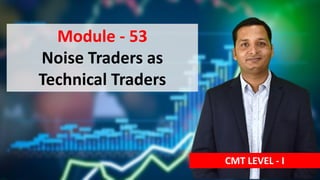
SECTION V - CHAPTER 34 - Noise Traders as technical Traders.pdf
- 1. Module - 53 Noise Traders as Technical Traders CMT LEVEL - I
- 2. Trend-Following Noise Traders • There are two things that are intriguing about stock price chart analysis: • (1) stock price charting is widely used, and • (2) users tend to agree on what many stock price chart patterns mean. • The first of these considerations implies that noise traders who are price chart traders represent a significant part of the actual trading community. • The second suggests that their behavior in the marketplace may be systematic.
- 3. Trend-Following Noise Traders • A noise trader using the extrapolative expectations, such as depicted in Figure 28.2, might pay little or no attention to fundamentals. • Bad news would not matter to such a noise trader, unless the bad news changed the pattern of stock prices so the extrapolation would lead to some different forecast. • If there is a large number of noise traders defined in this way, then one would expect some self-fulfilling aspect of such trading behavior.
- 4. Reversal Patterns in Stock Prices • A market reversal takes place when a rising (falling) price trend becomes a falling (rising) price trend. What stock price patterns predict reversals There are many such as : • Island Reversals • Head & Shoulder Patterns • This line of reasoning suggests that trend following is likely to be systematic. • Defenders of the EMH argue that noise traders will tend to cancel one another out, and something like the Law of Large Numbers will take hold, so that, in the aggregate, noise trader activity won't matter. But if the noise traders are all doing pretty much the same thing, then the cancel-out argument no longer applies.
- 5. Abreu-Brunnermeier Model • Abreu and Brunnermeier (2003)7 provide a noise trader model designed to deal specifically with bubbles and crashes. • AB assume that prices begin to diverge from efficient prices without any particular reason and the arbitrageurs observe the divergence. • The model permits the bubble to be burst by the combined action of the arbitrageurs, but it doesn't provide any certainty that the combined action of the arbitrageurs will ever successfully burst the bubble. • The Abreu-Brunnermeier (AB) model has the interesting feature that even arbitrage traders may find it in their interest to ride the wave of the bubble.
- 6. Herd Instinct Models • Herd instinct models are motivated by observing financial market booms and busts. • They are typically highly aggregative, and the herd behavior is usually summarized by a single-agent model representing the herd. • Market practitioners have observed cycles in financial markets that are often described as a “feeding frenzy.” • A price of a particular asset begins to rise then develops a momentum of its own, seemingly independent of any real fundamental change in the things that should determine its price.
- 7. The Shiller Model • Shiller builds his model of stock returns on the back of two different observations. • First, he notes that the prevailing thought at that time (the mid-1980s) was that the lack of forecast ability in stock returns implied investor psychology could not have much impact in financial markets. • Second, he notes that firms generally announce dividend movements in advance, implying that dividend movements are somewhat forecast able. • Since dividends should certainly have some impact on stock prices, but price movements are not very forecast able, the prices themselves must anticipate future dividend movements. • With investor psychology already ruled out as a factor, that leaves an optimal forecast of dividends as the only possible determinant of stock prices.
